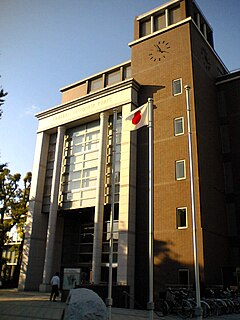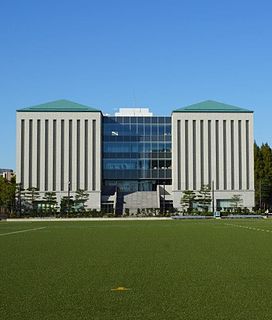Related Research Articles

Bilingual education involves teaching academic content in two languages, in a native and secondary language with varying amounts of each language used in accordance with the program model. Bilingual education refers to the utilization of two languages as means of instruction for students and considered part of or the entire school curriculum, as distinct from simply teaching a second language as a subject.

International students, or foreign students, according to the OECD are "those who received their prior education in another country and are not residents of their current country of study." In 2018, there were over 5.6 million international students, up from 1.6 million in 2000. By 2020, the U.S, U.K., Canada and Australia received approximately 50% of international students. The United States counted almost 1.1 million, the United Kingdom had more than 550,000, whilst there were 503,270 and 463,643 international students in Canada and Australia respectively.
The Fulbright Program, including the Fulbright–Hays Program, is one of several United States Cultural Exchange Programs with the goal to improve intercultural relations, cultural diplomacy, and intercultural competence between the American people of the United States and other countries through the exchange of persons, knowledge, and skills. Via the program, competitively-selected American citizens including students, scholars, teachers, professionals, scientists and artists may receive scholarships or grants to study, conduct research, teach, or exercise their talents abroad; and citizens of other countries may qualify to do the same in the United States. The program was founded by United States Senator J. William Fulbright in 1946 and is considered to be one of the most widely recognized and prestigious scholarships in the world. The program provides approximately 8,000 grants annually – roughly 1,600 to U.S. students, 1,200 to U.S. scholars, 4,000 to foreign students, 900 to foreign visiting scholars, and several hundred to teachers and professionals.

Secondary education in Japan is split into junior high schools, which cover the seventh through ninth grade, and senior high schools, which mostly cover grades ten through twelve.
The East–West Center (EWC), or the Center for Cultural and Technical Interchange Between East and West, is an education and research organization established by the U.S. Congress in 1960 to strengthen relations and understanding among the peoples and nations of Asia, the Pacific, and the United States. It is headquartered in Honolulu, Hawaii.

The Ministry of Education, Culture, Sports, Science and Technology, also known as MEXT, Monka-shō, is one of the eleven Ministries of Japan that composes part of the executive branch of the Government of Japan. Their goal is to improve the development of Japan in relation with the international community. They are responsible for funding research under their jurisdiction, some of which includes: children's health in relation to home environment, delta-sigma modulations utilizing graphs, gender equality in sciences, and other general research for the future.

A student exchange program is a program in which students from a secondary school or university study abroad at one of their institution's partner institutions.

Education in North Korea is universal and state-funded schooling by the government. The self-reported national literacy rate for citizens at age of 15 and older is 100 percent (approx.). Children go through one year of kindergarten, four years of primary education, six years of secondary education, and then on to university.
Studying abroad in the United States is for a mobile global education and intercultural awareness building opportunities. Studying abroad is determined in the United States by political rationales of national security and foreign policy. The number of students studying abroad represents only about 1% of all students enrolled at institutions of higher education in the United States.

Israeli–Japanese relations began on May 15, 1952, when Japan recognized Israel and an Israeli legation opened in Tokyo. In 1954 Japan's ambassador to Turkey assumed the additional role of minister to Israel. In 1955 a Japanese legation with a Minister Plenipotentiary opened in Tel Aviv. In 1963, relations were upgraded to Embassy level, and have remained on that level since then. Japan's trade relations with Arab League members and most Muslim-majority countries have taken a precedence over those with Israel. However, due to the declining price of oil in early 2015, as well as internal political shifting in Japan, the two nations are seeking increased research, economic and cultural ties, particularly in the area of tech start-ups and defense. Recently ties between Israel and Japan have strengthened significantly, with many mutual investments between the two nations. Japanese prime minister Shinzo Abe visited Israel twice – once in 2015 and a second time in 2018.

Kokushikan University is a private university in Setagaya, Tokyo, Japan.

The Institute of International Education (IIE) is a 501(c) organization which focuses on International Student Exchange and Aid, Foreign Affairs, and International Peace and Security. IIE creates programs of study and training for students, educators and professionals from various sectors. The organization says its mission is to "build more peaceful and equitable societies by advancing scholarship, building economies and promoting access to opportunity".

Dokkyo University is a private university in Sōka, Saitama, Japan, which is a liberal, co-educational institution noted for its language education programs and international exchanges. The university was founded in 1964, its roots can be traced back as early as 1881. Undergraduate admissions are selective, with an admission rate ranging from 30–40%.
Japanese language education in Vietnam first became widespread during the Empire of Vietnam, which was set up as a puppet state after Japan's 1941 World War II invasion of French Indochina. However, after Japan's 1945 surrender and withdrawal from Vietnam, there was little further education in the language until the 1970s. A 2006 survey showed 1,037 teachers teaching 29,982 students at 110 different institutions, an increase of 66% in the number of students since the previous year's survey.
United States cultural exchange programs, particularly those programs with ties to the Bureau of Educational and Cultural Affairs (ECA) of the United States Department of State, seek to develop cultural understanding between United States citizens and citizens of other countries. Exchange programs do not necessarily exchange one individual for another individual of another country; rather, "exchange" refers to the exchange of cultural understanding created when an individual goes to another country. These programs can be regarded as a form of cultural diplomacy within the spectrum of public diplomacy.
The Nippon Kaigi is Japan’s largest ultranationalist, far-right non-governmental organization and lobby. It was established in 1997 and has approximately 40,000 members. The group is influential in the legislative and executive branches of the Japanese government through its affiliates. Former Prime Minister Shinzō Abe, LDP politician, serves as a special advisor to the group's parliamentary league. Although the official membership is 40,000, it is unofficially affiliated with grassroots lawmakers and local politicians across the country.

The German University in Cairo is a private non-profit university in New Cairo City, Egypt. GUC was founded in 2002 by the presidential decree 27/2002 and according to the Egyptian law number 101/1992. The University of Stuttgart, the University of Ulm, the University of Tübingen, the University of Mannheim, the Academy of Fine Arts Leipzig, the German Academic Exchange Service (DAAD), the State of Baden-Württemberg, Germany, and the Federal Ministry of Education and Research, Germany, are among the main academic supporters of the GUC.
The Top Global University Project is a funding project by the Japanese government that began in 2014. The project aims to enhance the globalization of the country's public and private universities so that graduates can "walk into positions of global leadership". The project is sometimes referred to as 'TGUP'; it has also been (mis)translated directly in English as "Super Global Universities", and therefore referred to on some university websites as 'SGU' or 'SGUP'.
National Education Commission (1964-1966), popularly known as Kothari Commission, was an ad hoc commission set up by the Government of India to examine all aspects of the educational sector in India, to evolve a general pattern of education and to advise guidelines and policies for the development of education in India. It was formed on 14 July 1964 under the chairmanship of Daulat Singh Kothari, then chairman of the University Grants Commission. The terms of reference of the commission was to formulate the general principles and guidelines for the development of education from primary level to the highest and advise the government on a standardized national pattern of education in India. However, the medical and legal studies were excluded from the purview of the commission. The tenancy of the commission was from 1964 to 1966 and the report was submitted by the commission on 29 June 1966.
William L. Gertz is the Chairman, President and CEO of the American Institute For Foreign Study (AIFS), a cultural exchange and educational travel company with 10 global locations, headquartered in Stamford, CT.
References
- ↑ "Culcon". Culcon.jusfc.gov. Retrieved 2014-03-06.CS1 maint: discouraged parameter (link)
- ↑ "カルコン:日米文化教育交流会議>合同会議>CULCON XXIII>the CULCON Report". Jpf.go.jp. 1961-06-22. Retrieved 2014-03-06.CS1 maint: discouraged parameter (link)
- ↑ "CULCON 50th Anniversary Film". YouTube. 2012-04-16. Retrieved 2014-03-06.CS1 maint: discouraged parameter (link)
- ↑ "Cultural Relations - Major Documents". Aboutusa.japan.usembassy.gov. Retrieved 2014-03-06.CS1 maint: discouraged parameter (link)
- ↑ "Submission of the Report of the U.S.-Japan Conference on Cultural and Educational Interchange (CULCON) Education Task Force to Prime Minister Shinzo Abe | Ministry of Foreign Affairs of Japan". Mofa.go.jp. 2013-06-13. Retrieved 2014-03-06.CS1 maint: discouraged parameter (link)
- ↑ "Embassy News". Embassy of the United States Tokyo, Japan. 2012-10-17. Retrieved 2014-03-06.CS1 maint: discouraged parameter (link)
- ↑ "Report of the CULCON Education Task Force" (PDF). Mext.go.jp. Retrieved 2014-03-06.CS1 maint: discouraged parameter (link)